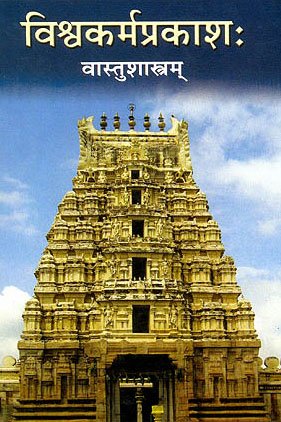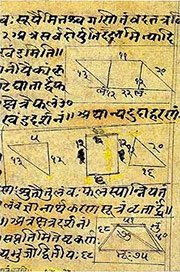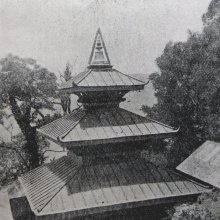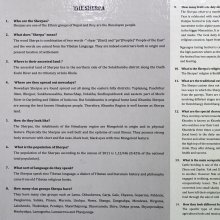Shanku, Samku, Sanku, Saṅku, Śaṅku, Shamku: 30 definitions
Introduction:
Shanku means something in Buddhism, Pali, Hinduism, Sanskrit, the history of ancient India, Marathi, Jainism, Prakrit, Hindi, Tamil. If you want to know the exact meaning, history, etymology or English translation of this term then check out the descriptions on this page. Add your comment or reference to a book if you want to contribute to this summary article.
The Sanskrit term Śaṅku can be transliterated into English as Sanku or Shanku, using the IAST transliteration scheme (?).
Images (photo gallery)
In Hinduism
Vastushastra (architecture)
Source: Wisdom Library: Vāstu-śāstraŚaṅku (शङ्कु) refers to a type of temple (prāsāda) classified under the group named Triviṣṭapa, according to Samarāṅgaṇasūtradhāra chapter 49. The Triviṣṭapa group contains ten out of a sixty-four total prāsādas (temples) classified under five prime vimānas (aerial car/palace), which were created by Brahmā for as many gods (including himself). This group represents temples (e.g. Śaṅku) that are to be octangular in shape. The prāsādas, or ‘temples’, represent the dwelling place of God and are to be built in towns. The Samarāṅgaṇasūtradhāra is an 11th-century encyclopedia dealing with various topics from the Vāstuśāstra.
Śaṅku is mentioned in another list from the Samarāṅgaṇasūtradhāra chapter 56, being part of the group named Lalita, containing 25 unique temple varieties.
Source: OpenEdition books: Architectural terms contained in Ajitāgama and RauravāgamaŚaṅku (शङ्कु) refers to “gnomon § 2.22.”.—(For paragraphs cf. Les enseignements architecturaux de l'Ajitāgama et du Rauravāgama by Bruno Dagens)

Vastushastra (वास्तुशास्त्र, vāstuśāstra) refers to the ancient Indian science (shastra) of architecture (vastu), dealing with topics such architecture, sculpture, town-building, fort building and various other constructions. Vastu also deals with the philosophy of the architectural relation with the cosmic universe.
Purana and Itihasa (epic history)
Source: archive.org: Puranic Encyclopedia1) Śaṅku (शङ्कु).—A son of Hiraṇyākṣa. Śambara, Śakuni, Dvimūrdhā, Śaṅku and Ārya were the sons of Hiraṇyāksa (Agni Purāṇa, Chapter 19).
2) Śaṅku (शङ्कु).—A Yādava King who was present at the wedding of Draupadī. (Ādi Parva, Chapter 185, Verse 19).
2) He was a member of the company of Yādavas, who carried Subhadrā’s dowry at her wedding with Arjuna. He was a mahārathī also. (Sabhā Parva, Chapter 14 and Ādi Parva, Chapter 220).
Source: archive.org: Shiva Purana - English TranslationŚaṅku (शङ्कु) refers to “geese” (a goose), according to the Śivapurāṇa 2.2.22. Accordingly as Brahmā narrated to Nārada:—“[...] On the top of the mountain near the city of Himālaya (śailarājapura), Śiva sported about for a long time in the company of Satī. [...] kinds of birds flew there, such as—Cakravāka, Kādamba, swans, geese (Śaṅku), the intoxicated Sārasas, cranes, the peacocks etc. The sweet note of the male cuckoo reverberated there”.
Source: Cologne Digital Sanskrit Dictionaries: The Purana Index1a) Śaṅku (शङ्कु).—A son of Ugrasena;1 a follower of Bali.2
- 1) Bhāgavata-purāṇa IX. 24. 24; Brahmāṇḍa-purāṇa III. 71. 33; Matsya-purāṇa 44. 74; Viṣṇu-purāṇa IV. 14. 20.
- 2) Matsya-purāṇa 245. 31.
1b) A son of Kṛṣṇa and Satyā.*
- * Bhāgavata-purāṇa X. 61. 13.
1c) A son of Ūrjā and Vasiṣṭha.*
- * Brahmāṇḍa-purāṇa II. 11. 42.
1d) One hundred thousand crores.*
- * Vāyu-purāṇa 101. 97.
Śaṅku (शङ्कु) is a name mentioned in the Mahābhārata (cf. I.90.94) and represents one of the many proper names used for people and places. Note: The Mahābhārata (mentioning Śaṅku) is a Sanskrit epic poem consisting of 100,000 ślokas (metrical verses) and is over 2000 years old.

The Purana (पुराण, purāṇas) refers to Sanskrit literature preserving ancient India’s vast cultural history, including historical legends, religious ceremonies, various arts and sciences. The eighteen mahapuranas total over 400,000 shlokas (metrical couplets) and date to at least several centuries BCE.
Jyotisha (astronomy and astrology)
Source: Google Books: Studies in the History of the Exact Sciences (Astronomy)Śaṅku (शङ्कु) refers to a “gnomon”, according to Bhāskara’s commentary on the Āryabhaṭīya.—Accordingly, “'[...] ‘It is only a rough method (sthūlaḥ kalpaḥ) to say that the one-sixtieth part of the water that has been discharged in the course of a nychthemeron is the measure of one ghaṭikā. The more accurate method is to measure the ghaṭikā by marking the shadow of one ghaṭikā, cast by a gnomon [i.e., śaṅku] of specified shape that has been set up on a level ground. The perforation in [the bowl of] the ghaṭikā-yantra should be made skilfully according to the period measured by the shadow.’ [...]”.
Source: Wikibooks (hi): Sanskrit Technical TermsŚaṅku (शङ्कु).—1. Gnomon. 2. The R sine of the altitude of a heavenly body. Note: Śaṅku is a Sanskrit technical term used in ancient Indian sciences such as Astronomy, Mathematics and Geometry.

Jyotisha (ज्योतिष, jyotiṣa or jyotish) refers to ‘astronomy’ or “Vedic astrology” and represents the fifth of the six Vedangas (additional sciences to be studied along with the Vedas). Jyotisha concerns itself with the study and prediction of the movements of celestial bodies, in order to calculate the auspicious time for rituals and ceremonies.
Ganitashastra (Mathematics and Algebra)
Source: archive.org: Hindu MathematicsŚaṅku (शङ्कु) refers to “ten trillion” (10,000,000,000,000) in various lists of numeral denominations, according to gaṇita (“science of calculation”) and Gaṇita-śāstra, ancient Indian mathematics and astronomy.—We can definitely say that from the very earliest known times, ten has formed the basis of numeration in India. While the Greeks had no terminology for denominations above the myriad (104), and the Romans above the milk (103), the ancient Hindus dealt freely with no less than eighteen denominations [e.g., śaṅku]. Cf. Yajurveda-saṃhitā (Vājasanyī) XVII.2; Taittirīya-saṃhitā IV.40.11, VII.2.20.1; Maitrāyaṇī-saṃhitā II.8.14; Kāṭhaka-saṃhitā XVII.10, XXXIX.6; Anuyogadvāra-sūtra 142; Āryabhaṭīya II.2; Triśatikā R.2-3; Gaṇitasārasaṃgraha I.63-68.

Ganitashastra (शिल्पशास्त्र, gaṇitaśāstra) refers to the ancient Indian science of mathematics, algebra, number theory, arithmetic, etc. Closely allied with astronomy, both were commonly taught and studied in universities, even since the 1st millennium BCE. Ganita-shastra also includes ritualistic math-books such as the Shulba-sutras.
Shaivism (Shaiva philosophy)
Source: eScholarship: The descent of scripture: a history of the KamikagamaŚaṅku (शङ्कु) refers to a “gnomon”, according to the Kāmikāgama: an ancient Śaiva Āgama scripture in 12,000 Sanskrit verses dating to at least the 5th century and represented as an encyclopedic account of ritual instructions (kriyāpāda).—In modern print editions, the Kāmika-āgama is structured in two major parts. The Pūrvabhāga consists of 75 chapters (paṭalas) [...] Chapters 9 to 34 present a general account of the principles and preliminary rites for the construction of temples, houses, buildings, and settlements. [...] In Chapter 15, we find instructions for the placement of a gnomon (śaṅku-sthāpana). Chapters 16 and 17 describe the instruments to be used for measurements and the placement of a construction diagram.

Shaiva (शैव, śaiva) or Shaivism (śaivism) represents a tradition of Hinduism worshiping Shiva as the supreme being. Closely related to Shaktism, Shaiva literature includes a range of scriptures, including Tantras, while the root of this tradition may be traced back to the ancient Vedas.
General definition (in Hinduism)
Source: archive.org: Vedic index of Names and SubjectsŚaṅku (शङ्कु) in the Rigveda and later denotes a ‘wooden peg’. Thus the term is used of the pegs by which a skin is stretched out in the Śatapatha-brāhmaṇa (ii, 1, 1, 10), and of the pin of hobbles (paḍbīśa). In the Chāndogya-upaniṣad it may mean ‘stalk’ or ’fibre of a leaf’.
In Buddhism
Tibetan Buddhism (Vajrayana or tantric Buddhism)
Source: Wisdom Library: Tibetan BuddhismŚaṅku (शङ्कु) refers to one of the various Grahas and Mahāgrahas mentioned as attending the teachings in the 6th century Mañjuśrīmūlakalpa: one of the largest Kriyā Tantras devoted to Mañjuśrī (the Bodhisattva of wisdom) representing an encyclopedia of knowledge primarily concerned with ritualistic elements in Buddhism. The teachings in this text originate from Mañjuśrī and were taught to and by Buddha Śākyamuni in the presence of a large audience (including Śaṅku).

Tibetan Buddhism includes schools such as Nyingma, Kadampa, Kagyu and Gelug. Their primary canon of literature is divided in two broad categories: The Kangyur, which consists of Buddha’s words, and the Tengyur, which includes commentaries from various sources. Esotericism and tantra techniques (vajrayāna) are collected indepently.
India history and geography
Source: Heidelberg: Glory of the Tiruvanantapuram Padmanabhasvami TempleŚaṅku (शङ्कु) or Śaṅkukavi is the author of the Padmanābhodaya: a text talking about the Thiruvananthapuram temple.—Several works other than the Purāṇas speak about the glory of the Tiruvanantapuram temple. The unpublished Padmanābhodaya is a short kāvya of Śaṅku or Śaṅkukavi (eighteenth century CE), written at the instance of Ramavarma Yuvaraja, a nephew of King Martanda Varma of Travancore, on the Tiruvanantapuram temple.

The history of India traces the identification of countries, villages, towns and other regions of India, as well as mythology, zoology, royal dynasties, rulers, tribes, local festivities and traditions and regional languages. Ancient India enjoyed religious freedom and encourages the path of Dharma, a concept common to Buddhism, Hinduism, and Jainism.
Languages of India and abroad
Pali-English dictionary
Source: BuddhaSasana: Concise Pali-English Dictionarysaṅku : (m.) a stake; a spike.
Source: Sutta: The Pali Text Society's Pali-English DictionarySaṅku, (cp. Vedic śaṅku) a stake, spike; javelin M. I, 337; S. IV, 168; J. VI, 112; DhA. I, 69.—ayo° an iron stake A. IV, 131.

Pali is the language of the Tipiṭaka, which is the sacred canon of Theravāda Buddhism and contains much of the Buddha’s speech. Closeley related to Sanskrit, both languages are used interchangeably between religions.
Marathi-English dictionary
Source: DDSA: The Molesworth Marathi and English Dictionaryśaṅku (शंकु).—m S The gnomon or style of a dial. 2 A spike, nail, prong, pin, peg, stake, pale &c. generally. 3 A number, ten billions. 4 In modern translations. A cone. 5 The sine of the altitude of a heavenly body.
--- OR ---
sāṅkū (सांकू).—m ( H) A bridge, yet understood esp. of a bridge or a float of rude materials and hasty construction.
Source: DDSA: The Aryabhusan school dictionary, Marathi-Englishśaṅku (शंकु).—m The style of a dial. A spike. 10 billions. A cone.
--- OR ---
sāṅkū (सांकू).—m A bridge of rude materials.
Marathi is an Indo-European language having over 70 million native speakers people in (predominantly) Maharashtra India. Marathi, like many other Indo-Aryan languages, evolved from early forms of Prakrit, which itself is a subset of Sanskrit, one of the most ancient languages of the world.
Sanskrit dictionary
Source: DDSA: The practical Sanskrit-English dictionaryŚaṅku (शङ्कु).—[śaṅk-uṇ Uṇādi-sūtra 1.36]
1) A dart, spear, spike, javelin, dagger; oft. at the end of comp; शोकशङ्कुः (śokaśaṅkuḥ) 'the dart of grief', i. e. sharp or poignant grief; तथैव तीव्रो हृदि शोकशङ्कुर्मर्माणि कृन्तन्नपि किं न सोढः (tathaiva tīvro hṛdi śokaśaṅkurmarmāṇi kṛntannapi kiṃ na soḍhaḥ) Uttararāmacarita 3.35; R.8.93; Kirātārjunīya 16.15.
2) A stake, pillar, post, pale; महासुहयः सैन्धवः पड्वीशशङ्कून् संवृहेत् (mahāsuhayaḥ saindhavaḥ paḍvīśaśaṅkūn saṃvṛhet) Bri. Up.6.1.13; निखातशङ्कुसंबद्धसैन्धवश्रेणिसंयुतम् (nikhātaśaṅkusaṃbaddhasaindhavaśreṇisaṃyutam) Siva B.2. 53.
3) A nail, pin, peg; बभूवु सप्त दुर्धर्षाः खादिरैः शङ्कुभि- श्चिताः (babhūvu sapta durdharṣāḥ khādiraiḥ śaṅkubhi- ścitāḥ) Mahābhārata (Bombay) 3.284.3; अयःशङ्कुचितां रक्षः शतघ्नीमथ शत्रवे (ayaḥśaṅkucitāṃ rakṣaḥ śataghnīmatha śatrave) (akṣipat) R.12.95.
4) The sharp head or point of an arrow, barb; Daśakumāracarita 1.1.
5) The trunk (of a lopped tree), stump, pollard.
6) The pin of a dial.
7) A measure of twelve fingers.
8) A measuring-rod.
9) The sine of altitude (in astr.).
1) Ten billions.
11) The fibres of a leaf; यथा शङ्कुना सर्वाणि पर्णानि संतृण्णानि (yathā śaṅkunā sarvāṇi parṇāni saṃtṛṇṇāni) Ch. Up. 2.23.3.
12) An ant-hill.
13) The penis.
14) The skate-fish.
15) A demon.
16) Poison.
17) Sin; crime.
18) An aquatic animal, particularly, a goose.
19) Name of Śiva.
2) The Sāla tree.
21) A kind of perfume (nakhī).
22) Name of Kāma, the god of love.
Derivable forms: śaṅkuḥ (शङ्कुः).
Source: Cologne Digital Sanskrit Dictionaries: Shabda-Sagara Sanskrit-English DictionaryŚaṅku (शङ्कु).—m.
(-ṅkuḥ) 1. The trunk of a lopped tree. 2. A javelin, a spear. 3. A pin, a stake, a pale. 4. The gnomon of a dial, usually twelve fingers long. 5. A long thin column in front of a pagoda. 6. The penis. 7. A number. 8. The small fibres of a leaf. 9. The scate fish, (Raia Sankur, Ham.) 10. A sort of perfume, commonly Nak'hi. 11. A goose. 12. An ant-hill. 13. A goblin, a demon. 14. A Gand'harba attached to Siva. 15. A name of Siva. 16. Kama. 17. Sin. 18. Fear, terror. 19. The pointed head of an arrow, a shaft. 20. A measuring rod. 21. A large number “ten billions.” 22. Poison. 23. Sine of altitude, (in astro.) E. śaki to doubt or apprehend, aff. uṇ .
--- OR ---
Saṅku (सङ्कु).—m.
(-ṅkuḥ) A hole.
Source: Cologne Digital Sanskrit Dictionaries: Benfey Sanskrit-English DictionaryŚaṅku (शङ्कु).—[śaṅk + u], (partly śak + u, cf. śakti), m. 1. Fear. 2. Śiva. 3. Kāma. 4. A demon. 5. Poison. 6. Sin. 7. A pin, [Hitopadeśa] iv. [distich] 69; a pale, a style, [Mānavadharmaśāstra] 8, 271; a stake. 8. The trunk of a lopped tree. 9. A dart, [Uttara Rāmacarita, 2. ed. Calc., 1862.] 75, 12; a javelin, [Pañcatantra] 87, 12 (cf. [Hiḍimbavadha] 2, 4); a weapon in general. 10. A goose. 11. An ant-hill. 12. A skate. 13. A number, ten billions. 14. A tree, Shorea robusta.
Source: Cologne Digital Sanskrit Dictionaries: Cappeller Sanskrit-English DictionaryŚaṅku (शङ्कु).—[masculine] a pointed peg or wooden nail, stake, pike, beam, arrow, spear, sting (lit. & [figuratively]), [Name] of a serpent-demon etc.
Source: Cologne Digital Sanskrit Dictionaries: Monier-Williams Sanskrit-English Dictionary1) Śaṅku (शङ्कु):—[from śaṅk] 1. śaṅku m. (for 2. See [column]2) fear, terror, [Horace H. Wilson]
2) 2. śaṅku m. (of doubtful derivation) a peg, nail, spike, [Ṛg-veda] etc. etc.
3) a stick, [Harivaṃśa]
4) a stake, post, pillar, [Mahābhārata]
5) an arrow, spear, dart ([figuratively] applied to the ‘sting’ of sorrow, pain etc.; cf. śankā-, śoka-ś etc.), [Harivaṃśa; Kāvya literature; Rājataraṅgiṇī]
6) a [particular] weapon or any weapon, [cf. Lexicographers, esp. such as amarasiṃha, halāyudha, hemacandra, etc.]
7) the pin or gnomon of a dial (usually twelve fingers long), [Colebrooke]
8) a kind of forceps (used for the extraction of a dead fetus), [Suśruta]
9) the fibre or vein of a leaf, [Chāndogya-upaniṣad]
10) the measure of twelve fingers, [cf. Lexicographers, esp. such as amarasiṃha, halāyudha, hemacandra, etc.]
11) (in [astronomy]) the sine of altitude, [Sūryasiddhānta]
12) a [particular] high number, ten billions (compared to an innumerable collection of ants), [Mahābhārata; Rāmāyaṇa]
13) the clapper of a bell, [Govardh.] ([cf. Lexicographers, esp. such as amarasiṃha, halāyudha, hemacandra, etc.] also the penis; poison; Unguis Odoratus; a [particular] tree or the trunk of a lopped tree; a [particular] fish [accord. to some ‘the skate fish’] or aquatic animal; a goose; a measuring rod; a Rākṣasa; Name of Śiva; of a Gandharva attendant on Śiva; of Kāma; of a Nāga; = aṃśa)
14) Name of a man [gana] gargādi
15) of a Dānava, [Harivaṃśa]
16) of a Vṛṣṇi (son of Ugra-sena), [Mahābhārata; Harivaṃśa; Purāṇa]
17) of a son of Kṛṣṇa, [Harivaṃśa]
18) of a poet (= śaṅkuka q.v.), [Catalogue(s)]
19) of a. Brāhman, [Buddhist literature]
20) n. Name of a Sāman, [Ārṣeya-brāhmaṇa]
21) Saṅku (सङ्कु):—(?) m. a hole, [Horace H. Wilson]
Source: Cologne Digital Sanskrit Dictionaries: Yates Sanskrit-English Dictionary1) Śaṅku (शङ्कु):—(ṅkuḥ) 2. m. The trunk of a lopped tree; scate fish; javelin; stake; a number; fear; fibres of a leaf; sin; a gnomon; demon; goose; ant-hill; Shiva; Kāma.
2) Saṅku (सङ्कु):—(ṅkuḥ) 1. m. A hole.
Source: DDSA: Paia-sadda-mahannavo; a comprehensive Prakrit Hindi dictionary (S)Śaṅku (शङ्कु) in the Sanskrit language is related to the Prakrit word: Saṃku.
[Sanskrit to German]
Sanskrit, also spelled संस्कृतम् (saṃskṛtam), is an ancient language of India commonly seen as the grandmother of the Indo-European language family (even English!). Closely allied with Prakrit and Pali, Sanskrit is more exhaustive in both grammar and terms and has the most extensive collection of literature in the world, greatly surpassing its sister-languages Greek and Latin.
Hindi dictionary
Source: DDSA: A practical Hindi-English dictionaryShanku in Hindi refers in English to:—(nm) a cone; -[kona] conical angle; —, [khokhala] hollow cone; —, [thosa] solid cone; ~[phala] a cone; -[bimdu] conical point; -[rupa] conical; —, [vrittiya] circular cone..—shanku (शंकु) is alternatively transliterated as Śaṃku.
...
Prakrit-English dictionary
Source: DDSA: Paia-sadda-mahannavo; a comprehensive Prakrit Hindi dictionarySaṃku (संकु) in the Prakrit language is related to the Sanskrit word: Śaṅku.
Prakrit is an ancient language closely associated with both Pali and Sanskrit. Jain literature is often composed in this language or sub-dialects, such as the Agamas and their commentaries which are written in Ardhamagadhi and Maharashtri Prakrit. The earliest extant texts can be dated to as early as the 4th century BCE although core portions might be older.
Kannada-English dictionary
Source: Alar: Kannada-English corpusŚaṃku (ಶಂಕು):—[noun] the large, spiral, univalve shell of any of various marine mollusks, used as a trumpet; a conch.
--- OR ---
Śaṃku (ಶಂಕು):—
1) [noun] a piece of hard material with two broad faces meeting in a sharply acute angle, that can be driven or forced into a narrow opening, as to split wood, raise a weight, etc.; a wedge.
2) [noun] a hard object, having a circular base and a vertex point on a different plane, the vertical cross section resembling a triangle; a cone.
3) [noun] an unhewn piece of a felled tree or a similar rough mass of wood.
4) [noun] an instrument that indicates time by the position of a gnomoṇs shadow cast by the sun on the face of a dial marked in hours; a sun-dial.
5) [noun] an instrument of a surveyor used in measuring lands.
6) [noun] a skate fish.
7) [noun] spear or javelin.
8) [noun] a hole (as driven or bored into a solid object).
9) [noun] the condition or quality of being complex; complexity.
10) [noun] a destroying or being destroyed; destrution.
11) [noun] (math.) the cardinal number ten billion.
--- OR ---
Saṃku (ಸಂಕು):—[noun] the large, spiral, univalve shell of any of various marine mollusks, used as a trumpet; a conch.
--- OR ---
Saṃku (ಸಂಕು):—[noun] a wedge-like weapon.
Kannada is a Dravidian language (as opposed to the Indo-European language family) mainly spoken in the southwestern region of India.
Tamil dictionary
Source: DDSA: University of Madras: Tamil LexiconŚaṅku (ஶங்கு) noun < śaṅku. Spike, stake, pole, peg. See சங்கு⁵ [sangu⁵], 1.
Tamil is an ancient language of India from the Dravidian family spoken by roughly 250 million people mainly in southern India and Sri Lanka.
See also (Relevant definitions)
Starts with (+37): Sankucchaya, Sankuchchhaya, Sankuci, Sankula, Sankulya, Sankupatha, Shamkusthapane, Shanku poolu, Shankubaitiza, Shankuchaya, Shankuchi, Shankudhana, Shankujiva, Shankuka, Shankukarna, Shankukarnamukha, Shankukarneshvara, Shankukarni, Shankukarnin, Shankukavi.
Ends with (+16): Ashvashanku, Ayahshanku, Ayashanku, Ayashshanku, Bahushanku, Dantashanku, Dehashanku, Dyudalashanku, Garbhashanku, Ishthashanku, Kadvashanku, Konashanku, Kritrimatrishamku, Kushanku, Lauhashanku, Lohashanku, Madhyalagnashanku, Mahashanku, Padbishashanku, Padvimshashanku.
Full-text (+126): Garbhashanku, Shankutaru, Shankukarna, Shamku-pala, Sankuka, Shankushtha, Sankupatha, Shankuvriksha, Shankuphalika, Sankula, Shankuphala, Sankucchaya, Sankuci, Shankujiva, Shankavya, Trishanku, Shamku, Yupavatya, Mahashanku, Lohashanku.
Relevant text
Search found 43 books and stories containing Shanku, Samku, Saṃku, Śaṃku, Sanku, Saṅku, Śaṅku, Sāṅkū, Śanku, Shamku, Shangu; (plurals include: Shankus, Samkus, Saṃkus, Śaṃkus, Sankus, Saṅkus, Śaṅkus, Sāṅkūs, Śankus, Shamkus, Shangus). You can also click to the full overview containing English textual excerpts. Below are direct links for the most relevant articles:
Garga Samhita (English) (by Danavir Goswami)
Verse 5.8.42 < [Chapter 8 - The Killing of Kaṃsa]
Verses 5.8.36-37 < [Chapter 8 - The Killing of Kaṃsa]
Verse 8.13.74 < [Chapter 13 - A Thousand Names of Lord Balarāma]
Ramayana of Valmiki (by Hari Prasad Shastri)
Chapter 28 - Shuka in his turn enumerates the Enemy < [Book 6 - Yuddha-kanda]
The backdrop of the Srikanthacarita and the Mankhakosa (by Dhrubajit Sarma)
Part 7 - Comparison [of the Maṅkhakośa] with other koṣas < [Chapter V - The Maṅkhakośa]
The Skanda Purana (by G. V. Tagare)
Chapter 188 - The Groups of Mothers Cursed < [Section 1 - Tīrtha-māhātmya]
Chapter 142 - Greatness of the Trio of Gaṇapatis < [Section 1 - Tīrtha-māhātmya]
Chapter 22 - The Origin of Viśalyā < [Section 3 - Revā-khaṇḍa]
Sushruta Samhita, volume 1: Sutrasthana (by Kaviraj Kunja Lal Bhishagratna)
Trishashti Shalaka Purusha Caritra (by Helen M. Johnson)
Part 6: Vāsupūjya’s childhood < [Chapter II - Vāsupūjyacaritra]
Thirty-six weapons < [Notes]

